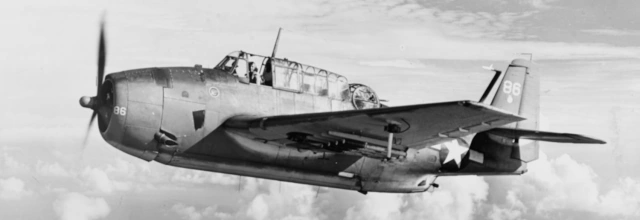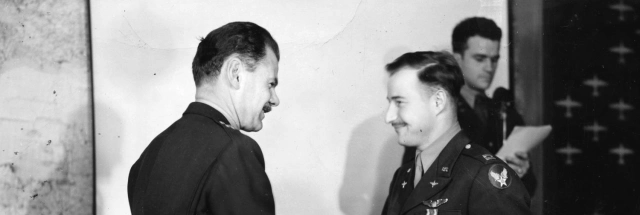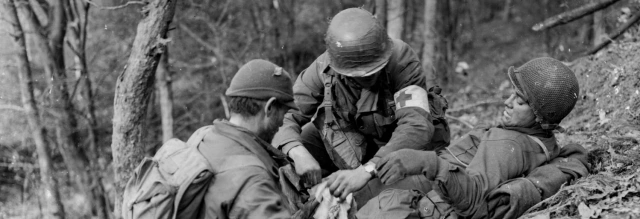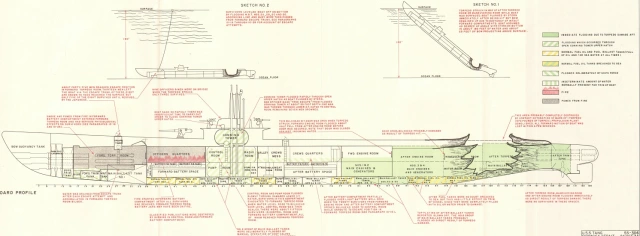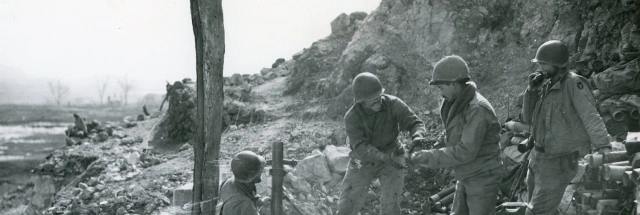| Hometown | Civilian Occupation |
| Wilmington, Delaware | Worker at Dravo shipyard |
| Branch | Service Number |
| U.S. Army Air Forces | 32488637 |
| Theater | Unit |
| Mediterranean | 32nd Photo Reconnaissance Squadron |
| Military Occupational Specialty | Awards |
| 747 (airplane and engine mechanic) | Purple Heart |
Early Life & Family
Joseph Martin Vignola was born at 114 East 2nd Street in Wilmington, Delaware, on the afternoon of November 5, 1920. He was the second child of Carmen Vignola (née Carmino Vignolo, a fish dealer, 1890–1975) and Filomena Vignola (Philomena Vignola in some records, née Alfonsus or Alfonso, 1894–1972). His father was an Italian immigrant, while his mother had been born in Pennsylvania. Vignola had an older brother, a younger brother, and a younger sister. His brothers both served in the U.S. Army during World War II.
Although his family moved several times, it appears that Vignola lived in Wilmington until he entered the service. On July 18, 1922, Vignola’s father purchased a property at 2119 Gilles Street. Although they later lived there, it appears the Vignolas might have used it as a rental property at first. The family was still living at 114 East 2nd Street as of February 1, 1926, when Vignola’s father petitioned for naturalization.
Vignola’s parents purchased a property at 509 West Fourth Street on March 15, 1926. The family was living there when they were recorded on the census on April 8, 1930. Vignola’s parents were listed at that address in a 1934 Wilmington directory and at 2119 Gilles Street in a 1938 directory. When he was recorded on the census on April 6, 1940, Vignola was living with his family at 2119 Gilles Street. He was described as a clerk and salesman at a fish department.
Vignola’s draft registration card is undated but appears to reflect changes to the Selective Training and Service Act implemented on December 20, 1941. When he registered, he was unemployed. The registrar described him as standing about five feet, six inches tall and weighing 143 lbs., with black hair and blue eyes. On the other hand, military records described him as standing five feet, four inches tall and weighing 148 lbs., with brown hair and gray eyes.
The Wilmington Morning News described him: “A graduate of St. Peter’s Parochial School, Corporal Vignola attended the Salesianum High School and was employed by the Dravo Company before entering the service.”
On the afternoon of April 11, 1942, Vignola married Dorothy McGowan (1922–2008) at St. Paul’s Roman Catholic Church in Wilmington. He was described as a laborer on his marriage certificate. It appears that the couple made their home at Vignola’s parents’ house. Later that year, the couple welcomed their first child, Philomena Vignola (later Mulshenock after her mother remarried and eventually Trala, 1942–2011).
The 1940 census stated that Vignola had completed one year of high school, while his enlistment data card had his highest level of education as two years of high school. In her statement for the State of Delaware Public Archives Commission, Vignola’s wife listed his occupation as store clerk. His enlistment data card described his occupation as “Unskilled occupations in building transportation equipment (except automobiles and aircraft),” which described other shipyard workers who joined the Army.
Military Career
After he was drafted, Vignola was inducted into the U.S. Army in Camden, New Jersey, on January 23, 1943. Vignola’s wife’s statement included a detailed list of his stateside assignments, albeit without dates. Private Vignola attended basic training at the U.S. Army Air Forces Miami Beach Training Center in Florida. He continued his training at the Academy of Aeronautics at LaGuardia Field, New York; in Newark, New Jersey; and with the Training Detachment, Army Air Forces Technical Training Command, Camp Bell, Bell Aircraft Corporation, Niagara Falls, New York. The Wilmington Morning News also stated that Vignola served at Roosevelt Field, New York.
On September 30, 1943, the Wilmington Morning News reported:
FOUR Wilmington men have been graduated from a special training school at Camp Bell, Niagara Falls, N. Y., Army Air Forces Eastern Technical Training Command, and are now specialists in the maintenance and repair of the P-39 Bell [Air Cobra] pursuit plane. They are: Corp. George Ambagais, 418 Shipley Street; Corp. Edward Sklodowski, 206 Eighth Avenue; Corp. Frank Totaro, 1740 West Fourth Street, and Corp. Joseph Vignola, 2119 Gilles Street.




Each P-39 Airplane Maintenance Course at Camp Bell took about a month and involved about 216 hours of training. The Bell Aircraft Corporation treated each graduating class to a ceremony and banquet at the nearby Red Coach Inn.
Corporal Vignola then transferred to the 124th Tactical Reconnaissance Squadron, joining the unit at Key Field, Mississippi, on September 3, 1943. One week later, however, he was one of four enlisted men transferred to the 32nd Photo Reconnaissance Squadron at Gainesville Army Air Field, Texas. Curiously, the 32nd was not equipped with the P-39.


The 32nd Photo Reconnaissance Squadron had been activated on August 15, 1943. The new squadron spent subsequent months training in Texas and Oklahoma. Corporal Vignola was listed on a roster of squadron enlisted personnel dated December 4, 1943. His military occupational specialty (M.O.S.) code was listed as 747, airplane and engine mechanic.
Per Special Orders No. 90, Headquarters Army Air Field Gainesville, Texas, dated December 29, 1943, Corporal Vignola was among the men assigned to the advance echelon for the 32nd Photo Reconnaissance Squadron’s move to Will Rogers Field, Oklahoma. The squadron completed its move in January 1944. The same month, the unit received Lockheed P-38 and F-5 Lightnings and North American B-25 Mitchells. The unit began practicing taking and printing aerial photos and fielded a basketball team named the Shutterbugs, compiling a record of 12 wins and three losses during the month.

During February 1944, the squadron finished most of its training, including bivouacking at Okmulgee Army Air Field, Oklahoma. The unit passed its preparation for overseas movement inspection on February 20, 1944. At 1000 hours on March 24, 1944, the squadron’s ground officers and enlisted men, including Corporal Vignola, headed east by train. They arrived at Camp Patrick Henry, Virginia, staging area for Hampton Roads Port of Embarkation, at 1630 hours on the afternoon of March 26, 1944. The pilots rejoined the rest of the squadron two days later. On March 31, 1944, 24 or 25 of the unit’s ground officers were ordered to proceed to port of embarkation the following day. These men, who soon boarded the Liberty ship S.S. Fitzhugh Lee, would never see their comrades again.
Most of the 32nd Photo Reconnaissance Squadron, including Corporal Vignola, boarded another Liberty ship, S.S. Paul Hamilton. There were also personnel from the 485th Bombardment Group (Heavy) aboard and a cargo of high explosives. Unfortunately, it was not uncommon for American ships during World War II to carry troops aboard ships loaded with volatile cargo.
On April 3, 1944, both ships carrying the 32nd Photo Reconnaissance Squadron departed for the Mediterranean Theater as part of Convoy UGS-38. The UG convoys were classified as either UGS (slow) or UGF (fast). Speed proved as important for protecting ships as escorts did. Fast convoys were exposed to the enemy for less time, and enemy submarines were less likely to be able to get into position to attack them. Not a single ship was ever lost to enemy attack while in a UGF convoy. The more common slow convoys were another matter, however.
UGS-38 passed through the Strait of Gibraltar on April 18, 1944. Up until that point, the principal danger had been from enemy submarines patrolling the Atlantic Ocean. Now that the ships were in the Mediterranean Sea, however, there was also a major risk of enemy air attack. The appearance of an enemy reconnaissance plane on the evening of April 20, 1944, meant that the men aboard ships in the convoy were not surprised by the air raid that materialized around 2100 hours, about 30 miles off Cape Bengut, Algeria.
Coast Guard Photographer’s Mate 2nd Class Arthur Green (probably 1912–1997) aboard U.S.S. Menges (DE-320), later recalled in an interview on June 28, 1944:
Well, the first two days into the Mediterranean it wasn’t much different than being out in the ocean. Then one evening at the sunset serenade, as we called it, we’d already been standing a battle station watch for two hours when Captain [F. M.] McCabe announced over the public address that an alert was on, that planes were reported. Well, that was a good distance away, of course, and probably would take some time before they got to us, but […] they did come in finally when the last ray of light disappeared from the western sky[.]
Shortly after dusk, 20–30 enemy torpedo bombers identified as Junkers Ju 88s barreled in at the convoy. Green continued: “Well, there wasn’t much time before Captain McCabe announced, ‘Planes on your port bow.’ […] and sure enough the antiaircraft guns started going off all around us[.]
Watching from Menges, Green recalled that suddenly,
a fire appeared just on our port beam, which developed into just about the largest flame I’ve ever seen. It went up about 2,5000 feet and a lot of smoke accompanying it and I just waited, of course, I had my camera ready and I waited for the flame to get up to the climax which was only a matter of seconds and then I exposed. I got a picture of this ammunition freighter, which I found out later was the Paul Hamilton.
Green added: “I got a picture of that, I didn’t realize at the time the importance or the tragedy involved[.]”
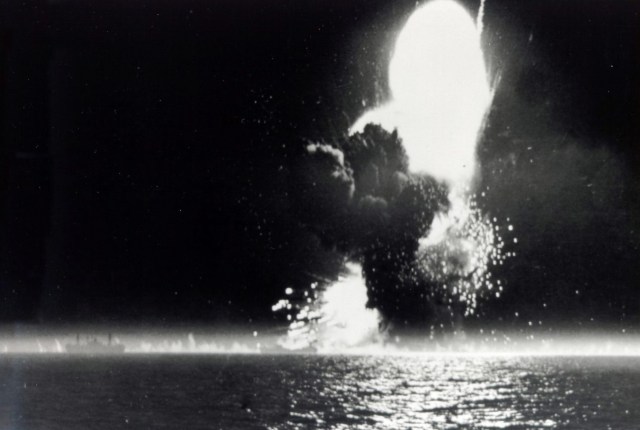
All indications are that S.S. Paul Hamilton sustained only a single torpedo hit, enough to detonate her cargo of explosives. In a moment, the 580 men aboard her were gone. The 32nd Photo Reconnaissance Squadron lost 317 men including all of its pilots and all 297 enlisted men, including Corporal Vignola.
2nd Lieutenant Julian Lowitt (1917–2001), a squadron intelligence officer and historical officer traveling aboard the S.S. Fitzhugh Lee, wrote that “The explosion of the Paul Hamilton blew in our hatch covers and covered our ship with oil and debris.”

The U.S. Army casualty list from the loss goes on for 21 pages. Of the approximately 491 soldiers aboard, only one body was recovered, that of 2nd Lieutenant Austin A. Anderle (1921–1944). Two other ships were also sunk during the attack, although with far less loss of life than the Paul Hamilton.
The few surviving officers of the 32nd Photo Reconnaissance Squadron arrived safely in Bari, Italy, on April 28, 1944. Within days of its arrival, the surviving officers had begun reconstituting the squadron. After transfers from other units, the 32nd Photo Reconnaissance Squadron began flying missions on May 19, 1944.
Corporal Vignola was posthumously awarded the Purple Heart. The Wilmington Morning News reported on June 8, 1944, that Corporal Vignola “is among the 504 American soldiers killed in the sinking of a transport in the Mediterranean last April.” Journal-Every Evening later reported that a “solemn requiem mass will be said for Joseph M. Vignola in St. Thomas’ Church” on the morning of September 23, 1944.
Boards of review in 1947 and 1949 concluded that bodies of Corporal Vignola and the others killed in the explosion were non-recoverable. Corporal Vignola and the others from the S.S. Paul Hamilton are honored on the Tablets of the Missing at the North Africa American Cemetery in Tunisia. Corporal Vignola is also honored at Veterans Memorial Park in New Castle, Delaware.
Dorothy McGowan Vignola was pregnant when her husband went overseas and gave birth to their second daughter that summer. She later remarried to Richard J. Mulshenock (1924–2000), who served in the Marine Corps during World War II. The couple raised Corporal Vignola’s daughters and six children of their own.
Notes
Survivors of the 32nd Photo Reconnaissance Squadron
Unit records are inconsistent about whether there were 24 or 25 ground officers who survived aboard the S.S. Fitzhugh Lee.
Squadron Name and Attachment
The American Battle Monuments Commission lists all the lost 32nd men as members of the 32nd Photographic Squadron, 5th Reconnaissance Group. All contemporary squadron records give its designation as 32nd Photo Reconnaissance Squadron. The 1982 reference book Combat Squadrons of the Air Force World War II agrees with the A.B.M.C. about the squadron being the 32nd Photographic Reconnaissance Squadron. However, the book states that the 32nd was not attached to the 5th Photographic Group until April 30, 1944, after the deaths of the men aboard the S.S. Paul Hamilton.
Acknowledgments
Thanks to the Delaware Public Archives for the use of their photo.
Bibliography
“12th Army Air Forces Technical Training Detachment Bell Aircraft Corporation Niagara Falls, New York 1 January to 7 July 1943.” Reel A2459. Courtesy of the Air Force Historical Research Agency.
Blye, George W. “Outline History of the 32nd Photo Reconnaissance Squadron for the period 1 May to 31 May 1944.” Reel A0887. Courtesy of the Air Force Historical Research Agency.
Certificate of Birth for Joseph Vignola. Record Group 1500-008-094, Birth Certificates. Delaware Public Archives, Dover, Delaware. https://www.familysearch.org/ark:/61903/3:1:S3HT-D4WS-7YF
Delaware Land Records, 1677–1947. Record Group 2555-000-011, Recorder of Deeds, New Castle County. Delaware Public Archives, Dover, Delaware. https://www.ancestry.com/imageviewer/collections/61025/images/31303_256972-00539, https://www.ancestry.com/imageviewer/collections/61025/images/31303_257007-00395, https://www.ancestry.com/imageviewer/collections/61025/images/31303_257051-00143
Delaware Marriages. Bureau of Vital Statistics, Hall of Records, Dover, Delaware. https://www.ancestry.com/imageviewer/collections/61368/images/TH-266-12312-35682-63
“Dorothy V. Mulshenock.” The News Journal, October 17, 2008. https://www.newspapers.com/article/135128786/
Fifteenth Census of the United States, 1930. Record Group 29, Records of the Bureau of the Census. National Archives at Washington, D.C. https://www.ancestry.com/imageviewer/collections/6224/images/4531892_00588, https://www.ancestry.com/imageviewer/collections/6224/images/4531894_01130
Green, Arthur. “Narrative by Arthur Green, PhoM2/c, USCG.” Interview on June 28, 1944. World War II Oral Histories, Interviews and Statements. Record Group 38, Records of the Office of the Chief of Naval Operations. National Archives at College Park, Maryland. https://catalog.archives.gov/id/278482612
“History 15 August 1943 to 30 September 1943.” Reel A0887. Courtesy of the Air Force Historical Research Agency.
Individual Deceased Personnel File for Joseph M. Vignola. Army Individual Deceased Personnel Files, 1942–1970. Record Group 92, Records of the Office of the Quartermaster General, 1774–1985. National Archives at St. Louis, Missouri. Courtesy of U.S. Army Human Resources Command.
Lowitt, Julian. “Outline History, 32nd Photo Rcn. Squadron, San Severo, Italy, Month of March, 1944.” Reel A0887. Courtesy of the Air Force Historical Research Agency.
Lowitt, Julian. “Outline History of 32nd Photo Rcn. Squadron for month of April, 1944.” May 6, 1944. Reel A0887. Courtesy of the Air Force Historical Research Agency.
“Mass for Soldier.” Journal-Every Evening, September 19, 1944. https://www.newspapers.com/article/135192800/
Maurer, Maurer, ed. Combat Squadrons of the Air Force World War II. Albert F. Simpson Historical Research Center and Office of Air Force History, 1982. https://archive.org/details/CombatSquadronsOfTheAirForceWWII
Naturalization Petitions of the U.S. District and Circuit Courts For the District of Delaware, 1795-1930. Record Group 21, Records of District Courts of the United States. National Archives at Washington, D.C. https://www.ancestry.com/imageviewer/collections/1193/images/M1644_16-0785
“P-39 Airplane Maintenance Course.” Army Air Forces Eastern Technical Training Command, Camp Bell, Bell Aircraft Corp.” Undated, c. 1944. Reel A2459. Courtesy of the Air Force Historical Research Agency.
“Philomena J. Trala.” The News Journal, January 9, 2011. https://www.newspapers.com/article/the-news-journal-joseph-vignola-widow-ob/135128786/
Polk’s Wilmington (New Castle County, Del.) City Directory 1934-5. R. L. Polk & Company Publishers, 1934. https://www.ancestry.com/imageviewer/collections/2469/images/16084306
Polk’s Wilmington (New Castle County, Del.) City Directory 1938. R. L. Polk & Company Publishers, 1938. https://www.ancestry.com/imageviewer/collections/2469/images/16150195
Sixteenth Census of the United States, 1940. Record Group 29, Records of the Bureau of the Census. National Archives at Washington, D.C. https://www.ancestry.com/imageviewer/collections/2442/images/m-t0627-00552-00623
“Squadron History 32nd Photo Reconnaissance Squadron Will Rogers Field, Oklahoma February 1944 Installment.” Reel A0887. Courtesy of the Air Force Historical Research Agency.
“Squadron History 32nd Photo Reconnaissance Squadron Will Rogers Field, Oklahoma January 1944 Installment.” Reel A0887. Courtesy of the Air Force Historical Research Agency.
Vignola, Dorothy. Individual Military Service Record for Joseph Martin Vignola. October 22, 1946. Record Group 1325-003-053, Record of Delawareans Who Died in World War II. Delaware Public Archives, Dover, Delaware. https://cdm16397.contentdm.oclc.org/digital/collection/p15323coll6/id/21228/rec/2
“Weddings.” Wilmington Morning News, April 20, 1942. https://www.newspapers.com/article/135182312/
“Wilmington Man Dies When Transport Sinks.” Wilmington Morning News, June 8, 1944. https://www.newspapers.com/article/135192551/
“With the Service Men And the Auxiliaries.” Wilmington Morning News, September 30, 1943. https://www.newspapers.com/article/135233192/
World War II Army Enlistment Records. Record Group 64, Records of the National Archives and Records Administration. National Archives at College Park, Maryland. https://aad.archives.gov/aad/record-detail.jsp?dt=893&mtch=1&cat=all&tf=F&q=32488637&bc=&rpp=10&pg=1&rid=3099552
WWII Draft Registration Cards for Delaware, October 16, 1940 – March 31, 1947. Record Group 147, Records of the Selective Service System. National Archives at St. Louis, Missouri. https://www.ancestry.com/imageviewer/collections/2238/images/44003_05_00009-01787
Last updated on April 21, 2024
To have new profiles of fallen soldiers delivered to your inbox, please subscribe below.






